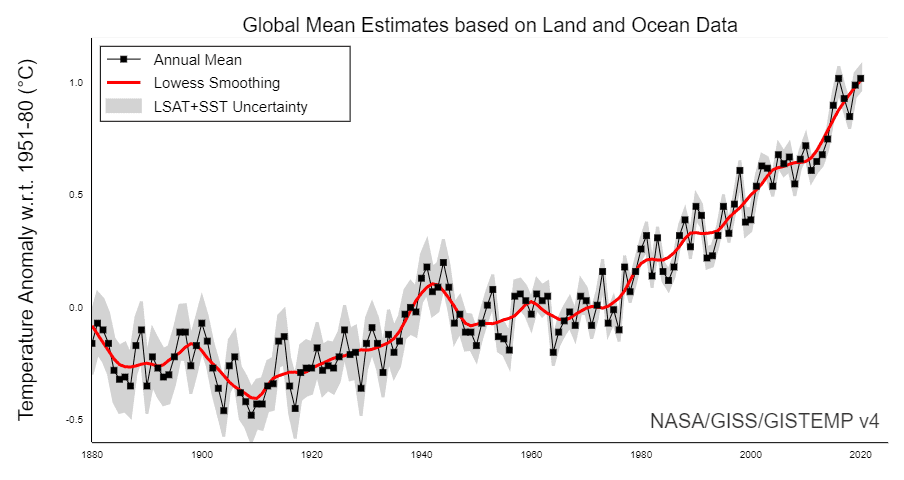A new analysis from several meteorological organisations confirms that 2020 was comfortably among the top three warmest years on record, and could be the warmest overall year on record allowing for statistical wiggle room.
The American National Oceanic and Atmospheric Administration (NOAA) placed 2020 as the Earth’s 2nd hottest year, just behind 2016, in its latest update on annual global temperatures published on Friday morning.
“The world’s seven-warmest years have all occurred since 2014, with 10 of the warmest years occurring since 2005”, wrote NOAA. “The average land and ocean surface temperature across the globe in 2020 was 0.98 of a degree C above average — just 0.02 of a degree C cooler than the 2016 record…the Northern Hemisphere saw its hottest year on record at .28 degrees C above the 20th-century average.”

NOAA scientists found that Australia has its fourth-warmest year since national records began in 1920, and that the southwest pacific ocean cyclone season had above average activity, with ten storms and five cyclones. “Australia’s decadal (2011–2020) temperature departure of 0.94°C (1.69°F) was the highest decadal temperature on record for the nation, surpassing the previous record set in 2001–2010 by 0.33°C (0.59°F)”, wrote NOAA.
Scientists from the National Aeronautics and Space Administration (NASA) conducted their own analysis, and concluded that 2020 ties with 2016 for the position of warmest year on record, and indeed slightly beats 2016 but within the bounds of statistical variance.
“Continuing the planet’s long-term warming trend, the year’s globally averaged temperature was 1.84 degrees Fahrenheit (1.02 degrees Celsius) warmer than the baseline 1951-1980 mean,” wrote NASA’s Goddard Institute for Space Studies (GISS) in New York. “2020 edged out 2016 by a very small amount, within the margin of error of the analysis, making the years effectively tied for the warmest year on record”.

2020 was one of 3 hottest years on record, along with 2016 and 2019.
6 warmest years have been since 2015.
It was the warmest decade on record, continuing a long-term trend that shows no sign of reversal.
Temperatures are only part of the story#ClimateChange has many impacts pic.twitter.com/6YC1ICZGxs— World Meteorological Organization (@WMO) January 14, 2021
The call for greater focus on adaptation comes as the United Nations Environment Program (UNEP) released its ‘Adaptation Gap’ report, calling for greater financing and implementation of plans for adapting to climate change impacts.
“Annual adaptation costs in developing countries are estimated at USD 70 billion. This figure is expected to reach USD 140-300 billion in 2030 and USD 280-500 billion in 2050”, writes the UNEP. The report cites Australia’s severe 2019/20 Black Summer bushfire season as an example of growing climate impacts.
The Bureau of Meteorology’s annual climate statement for 2020 found that “warmth was persistent throughout the year, with 6 of 12 months placing in the ten warmest on record for each of mean, maximum, and minimum temperatures for their respective months”, and that “both mean annual maximum and minimum temperatures above average for all States and the Northern Territory”.
America’s weather and science agencies were recently mired a major controversy involving a collection of climate change deniers publishing unofficial opinion pieces but using the logos and seals of official government agencies in the US, including the Office of Science and Technology Policy. The Trump administration was quick to dismiss these individuals from their roles, despite only a few days remaining for the incendiary and hostile regime.
BREAKING: The White House has dismissed David Legates and @RyanMaue for their role in producing papers questioning the seriousness of climate change without approval: https://t.co/Fkjwf7aSHJ pic.twitter.com/3sIQD0U62l
— Capital Weather Gang (@capitalweather) January 12, 2021









